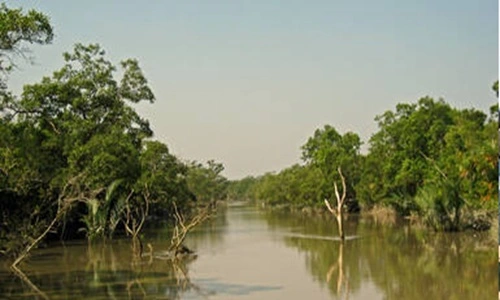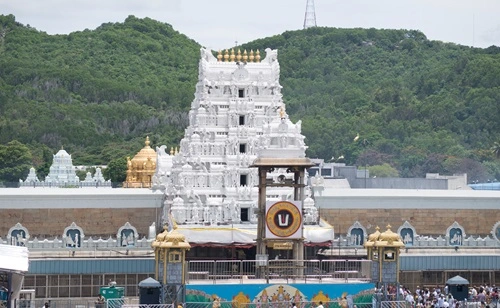From an outsider’s perspective, it might appear to you that India is very busy and there are little to no forests and wildlife here. But you’d be completely wrong. There are actually several forests and national parks in the country that can amaze and dazzle you with the variety of wildlife, terrain, vegetation, and things like that. And that is the very reason why we are here with a list of the top 10 biggest forests in India as of 2024. So, let’s not drag this intro thing any further and get started with the actual stuff, shall we?
1. Sundarbans – 10,277 km²

Spanning an impressive 10,277 km², the Sundarbans holds the title of India’s largest forest. The place is a UNESCO World Heritage Site, located at the confluence of the Ganges, Brahmaputra, and Meghna rivers, which run down into the Bay of Bengal. The area is significant not only for its vast biodiversity but also for having natural protection against cyclones and tsunamis, thus saving millions of people living along the coast. The Sundarbans are the home of Royal Bengal Tigers, which are uniquely adapted to such a watery landscape of tidal channels and mudflats.
2. Nilgiri Biosphere Reserve – 5,520 km²
The Nilgiri Biosphere Reserve spreads across 5,520 km² in the Western Ghats, spanning Tamil Nadu, Karnataka, and Kerala. The word ‘Nilgiris’ or ‘blue mountains’ comes from the purplish-blue flowers of the plant ‘Strobilanthes Kunthiana’, which blooms once in twelve years. National parks and sanctuaries forming part of the reserve are Mudumalai, Bandipur, Nagarhole, and Mukurthi, which are home to tigers, Asian elephants, and the Nilgiri tahr.
3. Namdapha National Park – 1,985.23 km²
Namdapha National Park, located in Arunachal Pradesh, covers 1,985.23 km² of land and is among the most biodiverse areas in the Eastern Himalayas. Its height varies from 200 m to over 4,500 m, having habitats from tropical rainforests to temperate and alpine forests. The unique assemblage of wildlife includes four species of big cats: the tiger, leopard, snow leopard, and clouded leopard. It’s also known for rare species like the red panda and the Namdapha flying squirrel, found only in this region.
4. Gir National Park – 1,410.30 km²
Gir National Park in Gujarat, covering 1,410.30 km², is the sole home of the Asiatic lion. Thanks to the special focus of conservation measures taken up in this sanctuary, the lion populations that were brought to the verge of extinction have been revived and today number around 650. Gir’s landscape of dry deciduous forests mixed with scrub and grasslands provides a perfect backdrop not just for the lions but also for leopards, hyenas, and chital. The teak forests in the park and its rich avian diversity make it a prime area for birds.
5. Jim Corbett National Park – 1,318 km²
Jim Corbett National Park, situated in Uttarakhand and covering 1,318 km², is for sure India’s first national park, established in 1936. It was established basically for the protection of Bengal tigers, which are very sensitive and endangered species, playing a vital role in initiating Project Tiger in 1973. Its landscape is hilly, with riverine belts, large marshy depressions, and grasslands. The park has a very wide variety of vegetation types and ecosystems too.
6. Kanha National Park (Kanha Tiger Reserve) – 940 km²
Located in Madhya Pradesh, Kanha National Park covers 940 km². It is not a park, but rather the most critical area for the conservation of Bengal tigers. Since its establishment in the year 1955 and the declaration as a Tiger Reserve in 1973, this national park has been a territory of thick sal forests, lush bamboo, and large grasslands. The large expanse of grassland is just ideal for different kinds of animals to flourish, including the endangered barasingha, which now, through the help of conservation work, is seeing a comeback. Bird lovers will definitely not be disappointed here, and one can spot a crested serpent eagle or an Indian roller in the middle of the woods too.
7. Bandipur National Park – 868.63 km²
In Karnataka, within the larger Nilgiri Biosphere Reserve, lies Bandipur National Park, covering 868.63 km². It is positioned at the crossroads of the Western Ghats and the Deccan Plateau and has mixed varieties of dry and moist deciduous forests. Bandipur was among the initial chosen sites for the protection of the Bengal Tiger under Project Tiger. Other major species found here include the Indian elephant, gaur, and dhole. It is an important park to conserve more than 200 species of birds, including the endangered Indian vulture.
8. Saranda Forest – 820 km²
Saranda Forest in Jharkhand, known as Asia’s largest sal forest, spans 820 km². It represents high biodiversity of both flora and fauna and is a site of crucial importance for the livelihood of the local community. In addition, it has a huge deposit of iron ore, which makes the site a controversial ground for the industry between conservation and mining. The forest sustains elephants, leopards, and numerous bird species, which all point to the need for a balanced approach to the conservation of this rich natural resource.
9. Mawphlang Sacred Grove – 302 km²
In Meghalaya, the Mawphlang Sacred Grove covers about 302 km² and is a unique example of traditional conservation by the local Khasi tribes. The Khasi consider this grove to be holy, untouched by human beings, and the ecosystem is prospering. It is filled with medicinal plants and different rare species of plants that are conserved due to the cultural practices of the Khasi tribes.
10. Pichavaram Forest – 110 km²
Near the coast of Tamil Nadu, the Pichavaram Forest extends over about 110 km² and is one of India’s most crucial mangrove ecosystems. It forms a home for several fish, birds, and marine life due to the islands and water channels that form out of it. The forest also serves the protective function of a natural defense against cyclones and tsunamis, and it is one of the examples of the protective function that mangroves perform against coastline erosion.
Conclusion
Sure, this list has come to an end, but there are several of these national parks and forests to explore in India. So, if you are intrigued enough, then you’ll likely find many more interesting things about India’s forests.

